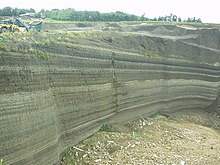Volcanic Eifel




The Volcanic Eifel or Vulkan Eifel (
Geographical location

The Volcanic Eifel stretches from the
The Volcanic Eifel is divided into three natural regions:
- Volcanic West Eifel (Hillesheim (within the parish of Nohn),
- Volcanic High Eifel (Ulmenand Nohn),
- Volcanic East Eifel (Brohltal, Vordereifel, Mendig, Pellenz)
The centre of the Volcanic Eifel is the region around Daun and Manderscheid and the areas within the
The landscape of the Volcanic Eifel is dominated by recent volcanism. Volcanic craters, thick pumice and basalt layers and maars create a diverse landscape that clearly witnesses to very recent events in geological terms.
The entire Volcanic Eifel covers an area of about 2,000 km2 (770 sq mi) and as of 2007[update] has a population of about 200,000.
Volcanoes
The following volcanoes belong to the Eifel, sorted by height in metres (m) above sea level (Normalhöhennull, NHN)[2]:
- Ernstberg (also: Erresberg), 699.9 m (2,300 ft), county of Vulkaneifel – west
- Scharteberg, 691.4 m (2,270 ft), county of Vulkaneifel; with the Eifel Transmitter (SWR) – west
- Prümscheid, 681 m (2,230 ft), county of Vulkaneifel – not volcanic (eponymous quartzite ridge; other summits being the Scharteberg and Dietzenley)
- Hochkelberg, 674.9 m (2,210 ft), county of Vulkaneifel; with a transmission mast on its south summit – Tertiary
- Nerother Kopf, 651.7 m (2,140 ft), county of Vulkaneifel; with the castle ruins of the Freudenkoppe – west
- Dietzenley, 617.6 m (2,030 ft), county of Vulkaneifel; with a wooden observation tower – west
- Arensberg, approximately 590 m (1,940 ft), county of Vulkaneifel – Tertiary
- Hochsimmer, 587.9 m (1,930 ft), county of Mayen-Koblenz – east
- Gänsehals, 573.3 m (1,880 ft), county of Mayen-Koblenz – east
- Engelner Kopf, 575.1 m (1,890 ft), county of Ahrweiler (near Kempenich-Engeln) – east
- Hochstein, 563 m (1,850 ft), county of Mayen-Koblenz – east
- Steineberger Ley, 557.8 m (1,830 ft), county of Vulkaneifel; with a Volcano Information Platform (observation tower) – Tertiary
- Rockeskyller Kopf, 554.6 m (1,820 ft), county of Vulkaneifel – west
- Hoher List, 549.1 m (1,800 ft), county of Vulkaneifel; with the Hoher List Observatory – west
- Wartgesberg, approximately 475 m (1,560 ft), county of Vulkaneifel (near Strohn) – west
- Veitskopf, 428.1 m (1,400 ft), county of Ahrweiler; near Laacher See; with an observation tower, the Lydia Tower – east
- Ettringen) – east
- Karmelenberg, 372.5 m (1,220 ft), county of Mayen-Koblenz – east
- Mayener Bellberg, 363.2 m (1,190 ft), county of Mayen-Koblenz (north of Mayen) – east
- Korretsberg, 295 m (970 ft), county of Mayen-Koblenz (near Kruft) – east
Laacher See
Of particular note is the volcanic caldera known as
Geopark and museums
- Vulkanland Eifel National Geopark
- Volcano Museum, Daun
- Volcano House, Strohn
- German Volcano Museum, Mendig
Geology
The
Future activity
There is thought that future eruptions may occur in the Eifel, as:[3][4]
- Each year the Eifel rises by about a millimetre.
- Geophysicists found that crust under the Eifel is thinner than most continental crust, suggesting that under the Eifel is a hot zone where magma is rising.
- Persistent small earthquakes and underground heating.
- Map of flood lake that may happen if the Rhine is blocked by a voluminous eruption in the Eifel
In 2020, Professor Kreemer noted that Eifel was the only region within an area of Europe studied where
References
- ^ ISSN 1476-4687. Retrieved 19 December 2023.
- ^ GeoViewer of the Federal Office of Geoscience and Resources (Bundesanstalt für Geowissenschaften und Rohstoffe)
- ^ Is there still volcanic activity in the Eifel?
- ^ Germany: a danger of volcanic eruptions?
- ^ a b c Kettley, Sebastian (11 June 2020). "Volcano warning: 'Something is brewing under Europe' Geologists make incredible discovery". Express. Retrieved 5 May 2021.
Further reading
- Wilhelm Meyer: Geologie der Eifel. Schweizerbart’sche Verlagsbuchhandlung, Stuttgart 2013. ISBN 978-3-510-65279-2
- Hans-Ulrich Schmincke: Vulkane der Eifel: Aufbau, Entstehung und heutige Bedeutung, Springer Spektrum, Wiesbaden 2014. ISBN 978-3-8274-2985-8
External links
- Homepage of Vulkaneifel district
- German Volcanological Society
- "East Eifel Volcanic Field". Global Volcanism Program. Smithsonian Institution. Retrieved 2021-06-25.
- "West Eifel Volcanic Field". Global Volcanism Program. Smithsonian Institution. Retrieved 2021-06-25.

